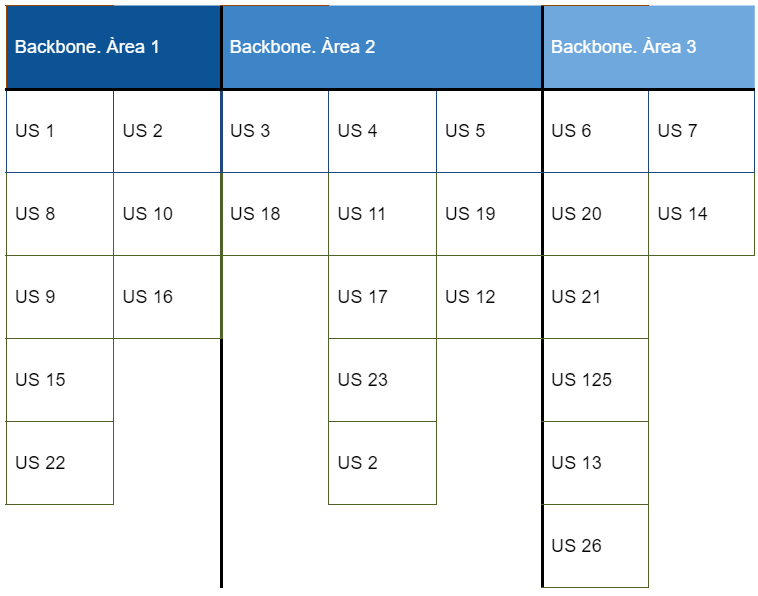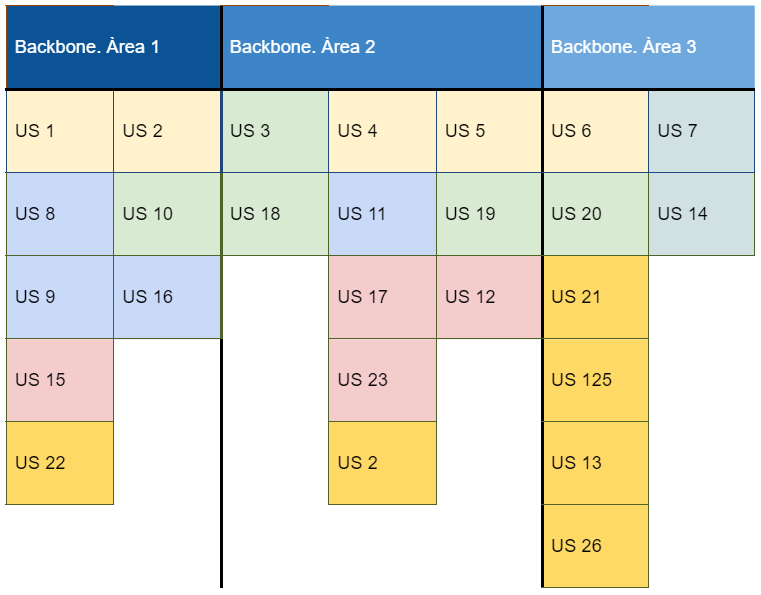When working with a product backlog, we quickly realize that, in complex projects, we have a large list of atomic needs, which does not allow us to have a clear vision of two aspects that are very important for the success of the project:
A product backlog, by itself, cannot answer these questions. We need a tool that allows us, on the one hand, to ensure that the items described in the product backlog respond to or are valid for the product goal. And, on the other hand, we need a tool that allows us to make a selection of items in order to advance in the construction of the product, providing at all times a minimum value increase (MVP) to users (and not simply a product).
User Story Mapping is a technique, devised by Jeff Patton in 2014 in his book “User Story Mapping: Discover the Whole Story, Build the Right Product”. With this technique it is possible to graphically see an arrangement of the items of a product backlog that shows at all times what value is provided or will be provided to users. And if this value responds to or justifies the objective of the product.
This is a constant task for all team members, and with responsibility for the product owner. This is the main person interested in having a clear vision of the overall performance of the product objective, and the most efficient selection or prioritization possible and aimed at providing users with the greatest possible degree of value.
This technique can be applied cyclically in refinements during the project.
In an agile development scenario, each product release is made with the intention of providing a functional increment of the product. To achieve this, it is not convenient to subdivide the project into the most obvious functional areas, since then we would not have a functional product until the last phases of the project, or even until the end of development. It is necessary to divide the product transversally, and include in each release the necessary portion of each functionality that becomes an incremental and usable product.
A subdivision that provides a product increment of value is called MMF: (minimum marketable feature) and corresponds to the minimum set of functionalities that by themselves provide a useful increment for users.
Thus, each MMF or set of MMFs can be fitted within the Scrum mechanism, so that the product backlog, sprint planning and release policy are already oriented with this incremental construction mentality.
To articulate this structuring of incremental deliveries, Jeff Patton (2009) proposes a collaborative work tool called visual story mapping. This tool consists of executing the following tasks:
The objective is to obtain a map that shows:
The result is similar to the following diagram:

This activity can be practiced at any time in the project when it is necessary for the team to work on a greater understanding of the items in the product backlog; and the value that they provide to users. These sessions are usually organized through refinements, which usually last 1 hour per session.
The first objective is to be able to, in a consensual manner, determine a set of high-level activities that make up the product goal. This is what Jeff Patton defines as the “BackBone”.
The definition and constant maintenance of this classification helps the team to answer the first question defined a few lines above: “Do the product backlog items meet the product goal?”
Once the main activities have been defined, it is the turn to place each of the product backlog items in one of these activities. This task is done periodically in order to always keep this classification up to date, and incorporate new items that appear in the product backlog as the project progresses, as well as possible changes to previous items.
Thus we have a picture like the one presented above. Now it is time to determine a horizontal subset that allows us to ensure that in each delivery we are able to provide a valuable product.
The team works on the previous grid to identify sets of user stories that provide value, while maintaining the balance between the cost (the sum of the story points of the selected stories) and the value provided.
The selection, which is dynamic and can vary in each session, determines which “packages” provide value in a way that is acceptable to the team with the available Sprint duration, and implies a consensus and commitment of technicians, Product Owner and stakeholders on “what will be done” and in what order.

User Story Mapping: Discover the Whole Story, Build the Right Product Jeff Patton (https://www.amazon.com/dp/1491904909/ref=cm_sw_r_as_gl_api_glt_fabc_943R88XEDXR0C93EARN1?linkCode=ml1&tag=jefpatass-20)